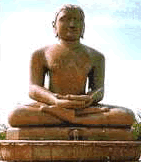Home :: Festival tour :: Mahavir Jayanti
MAHAVIR JAYANTI
FACTS & FIGURES Time of the year - March to April |
 Lord Mahavir |
THE FESTIVAL
The Jain community observes the birth anniversary of Lord Mahavira, the founder of Jainism with great devotion and on the occasion, special prayers are offered at the Jain temples and shrines. Mahavira Jayanti, as this day is called, falls on the 13th day of the bright half of the month of Chaitra according to the Hindu solar calendar. Mahavira Jayanti is the main Jain festival and is celebrated in March-April.
CELEBRATIONS
This religious event is ritually celebrated by the Jains who visit sacred sites and worship the Teerthankars. The event holds special significance in the states of Gujarat and Rajasthan because the ancient Jain shrines at Girnar, Dilwara, and Palitana are situated in these states. Mahavira Jayanti is also celebrated at the Parasnath temple in Calcutta and at Pawapuri in Bihar.
LEGENDS
The two sects, namely the Digambars and the Svetambaras, have slightly different stories related to the birth of Lord Mahavira. According to the Digambar school of Jainism, Lord Mahavira was born in 615 BC, but according to the Svetambaras, he was born in 599 BC. Though the two sects believe that he was the son of Siddharth and Trisala, the Digambars believe that the expectant mother had 16 auspicious dreams before the child was born and 14 dreams according to the Svetambaras. According to legends, Brahmin Rishabhdeva's wife Devananda conceived Lord Mahavira but the Gods transferred the embryo to queen Trisala's womb. The dreams of the expectant mother were interpreted by the astrologers who stated the child would either be an Emperor or a Teerthankar.
Born to King Siddharth and Queen Trisala of Vaisali (now in the state of Bihar), the Mahavira was named Vardhaman, as his father's kingdom and fame grew right from the time he was conceived. Like his contemporary, Gautam Buddha, Vardhaman renounced the world and his princely status, and began to live like an ascetic. By the time he was 30 years old, he had already been named the Mahavira (supremely brave) for acts of valor performed during his youth. The Mahavira taught ahimsa (non-violence) and love for all living beings. Kings and queens were among those who became his followers. After he attained enlightenment, the Mahavira was named Jina (victorious over karma), and his followers, Jains.
The Mahavira renounced worldly life at the age of 30 and undertook austere penance till he achieved realization. Not satisfied with keeping the knowledge of the highest good to himself, he spread the message of salvation to the world. Thus started the faith of the Jinas or victors of the soul. The Mahavira, however, is the last in a line of tirthankaras or 'bridge builders', the first being Lord Rishabh. There is evidence at Harappa to prove that the religion propagated by Lord Mahavira dates back to pre-Vedic times. It is also mentioned in the Rig Veda.
To the Jains, the Mahavira is the last of a line of 24 teachers known as tirthankaras. And Mahavira Jayanti is a day to remember and worship this teacher and all his predecessors.
PLACES TO VISIT
Gujarat, Rajasthan, Calcutta, Bihar, and other Jain priority areas of India are the places to visit to witness the celebrations of this quiet and solemn festival.



